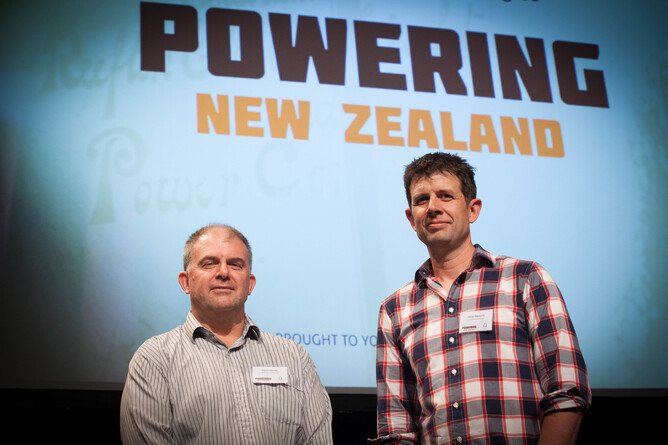The electricity industry is a frequent topic of discussion in New Zealand – especially as the months get colder and the power bills get higher.
Power bill grumbles aside, New Zealand’s electricity industry, supported and funded by the Government, achieved world-leading feats of engineering and power supply in its early stages at the turn of the 20th century.
The creation of massive state-owned hydroelectricity stations, and the people who helped make them happen, are captured in episode two of Powering New Zealand, which will premiere to an industry audience at Rutherford House in Wellington on Friday 13 July.
Powering New Zealand is a new five-part documentary series that uncovers the untold stories of New Zealand’s electricity inventors and pioneers, highlighting a wide range of electricity innovations with home-grown stories about hydroelectric power generation, the development of the electric fence, the world’s first all-electric house, and more.
Documentary creators and hosts Stephen Batstone and David Reeve have drawn on their combined 40 years of experience in the electricity industry on what they call their “passion project.”
“The stories and people behind New Zealand’s electricity industry are fascinating – but they’ve largely been forgotten,” says Batstone. “These people and their stories are well worth celebrating.”
Episode one of Powering New Zealand looked at the beginnings in Central Otago and Westland to see the Southern Hemisphere’s first hydroelectric power station and the first town in New Zealand, Reefton, to be lit by electricity.
Episode two explores the beginnings of state involvement in the electricity industry and the visionary engineers behind New Zealand’s hydroelectric power stations and the start of the national grid.
“In the 1900s New Zealand really led the way with government-funded, large-scale hydropower generation,” says Batstone.
Following the successful development of the Southern Hemisphere’s first hydroelectric power station in Bullendale, Central Otago, and the world’s first electric gold dredge, Sandhills on the Upper Shotover River, the Government was beginning to take notice.
“The government, at the time under Prime Minister Richard Seddon, saw an opportunity to up the ante with electricity generation – they wanted in,” says Reeve.
They brought in engineer Robert Fletcher, who had been instrumental in the Bullendale and Sandhills projects, to get them started, choosing Rotorua as a guinea pig town. There, they wanted to use electric motors to run the sewage system and electric lighting to increase tourism appeal.
“Fletcher chose Okere Falls on the Kaituna River to build, and that would become one of the first government-built hydroelectric power stations in the world, and it was the Okere Falls success that convinced the Government hydroelectricity had a big role to play in building the country,” says Reeve.
It resolved the New Zealand state would build only hydropower stations, a policy that survived several successive governments until 1958.
“Fletcher is a big name in New Zealand’s electricity history, yet we’ve never been able to find a photo of him, so unfortunately we can’t even put a face to all the contributions he made.”
According to Reeve, another electricity pioneer in the early 1900s was Glasgow-born engineer Peter Seton Hay, whose 1904 report on the rivers and lakes suited for hydropower generation is still regarded as the authority on the country’s hydro catchments.
“He travelled the length of the country putting the report together, and it’s still the first word and starting point for every major hydroelectric scheme in New Zealand, which is extraordinary considering it’s now well over 100 years old.
“It’s thanks to Hay that we have our major hydropower stations – Coleridge, Arapuni, Benmore, Karapiro, and Whakamaru, to name a few.”
But it wasn’t all growth and success for the government, and the previous surplus of energy New Zealanders had enjoyed was starting to wane. Coleridge engineer Frederick Kissel, who had become the resident engineer for the Public Works Department, found himself in the unfortunate position of implementing power rationing when World War II broke out.
Known as load control, power was rationed by ripples of pulses sent through power lines, where the timing of those pulses communicated to water heaters when to switch on or off.
“Kissel had a hard time,” says Reeve. “He really became the face of state-controlled power use and rationing.
“But he had done some amazing things too – he delivered a world-class hydropower station at Coleridge, had fixed the waterproofing issues that had plagued the Arapuni station, and was a key character in bringing hydroelectricity to New Zealand – something he cared very deeply about.”
Both Batstone and Reeve see Powering New Zealand as an effort to preserve history and to inspire people about what’s possible with the future of electricity.
“When we were researching we found that even people in the industry weren’t aware of this fascinating heritage,” says Reeve. “So we want people to see these stories and see that we’ve achieved some pretty massive things on a global scale in the past, and we’re still doing it, so what’s to stop us from making it a habit?”
Episode two of Powering New Zealand has been made with support from Mercury. To watch episode one, visit whiteboardenergy.co.nz/powering-nz/. Episode two will be available after 13 July.
To find out when new episodes are available, and to contribute to the series, like the Powering New Zealand Facebook page: Facebook.com/PoweringNewZealand

